Installing Ignition
Choose your operating system for detailed instructions on installing and uninstalling Ignition.
- Windows
- Mac OS X
- Linux
- Java 8+ (server), Java 6+ (client)
- Dual-Core Processor (32 or 64 bit)
- 4GB RAM
- 10GB free HD space
Also, ensure you have Administrator privileges to run the Ignition installer.
-
Go to the Inductive Automation website at www.inductiveautomation.com
-
Select Download Ignition in the upper right corner of the page.
-
On the Ignition Downloads page, scroll down to System Installers and select the ignition-X.X.X-windows-x64-installer.exe installer.
If your computer runs on a 32-bit Windows, click the ignition-X.X.X-windows-32-installer.exe installer.
noteAn error window is displayed if you try to install 64-bit Ignition on a 32-bit Windows system. You are allowed to install 32-bit Ignition on a 64-bit system (however, this is not recommended).
-
After the installer downloads, double-click on the .exe executable file to start installation.
The Setup window welcomes you to the Ignition Setup Wizard.
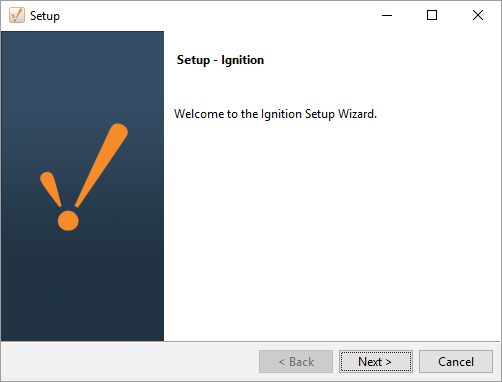
-
Click Next.
-
Click the I accept the agreement button and click Next.
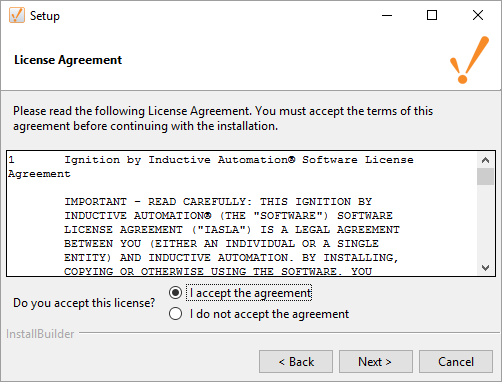
The Installation Directory window is displayed. By default, Ignition is installed under your Program Files directory. This is usually a good choice.
-
Make a note of the default installation directory, Program Files/Inductive Automation/Ignition, accept the default Installation Directory, and click Next.
The Installation Mode window is displayed.
-
Select the platform you wish to install. The rest of this guide will use Ignition as the platform.
New in 7.9.2For Ignition Edge installations, select the Ignition Edge radio button then skip to step 11. More information on Edge can be found on the Ignition Edge page.
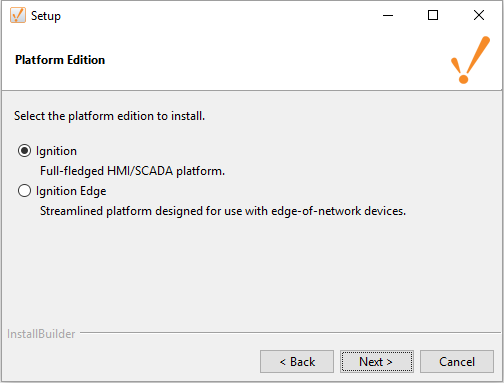
-
Select either the Typical or Custom mode.
The Typical installation includes Ignition with all of the HMI/SCADA modules. The only modules that are not installed by default are the MES modules.
The Custom installation lets you control and individually select the modules that you want installed.
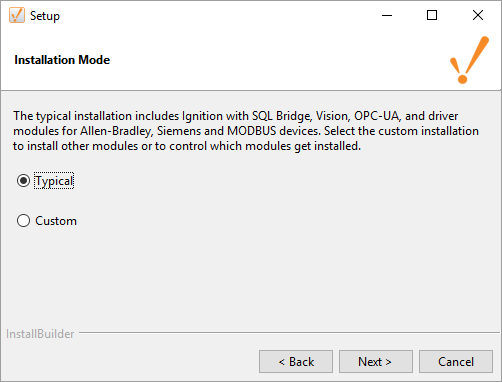
-
Click Next.
The Setup window is displayed.
If you selected Custom mode, in the Setup window you can select the check box next to the modules you want to install as part of the Ignition installation. To see a brief description of the module, click on the module name.
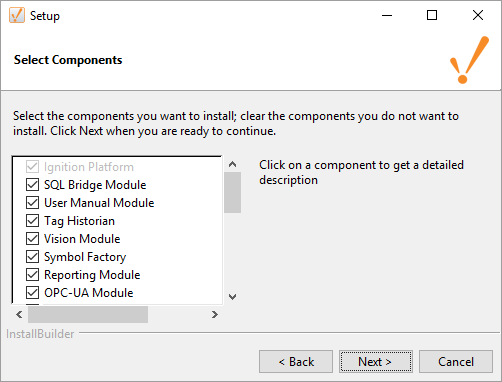
-
Click Next.
The Setup Wizard shows Ignition is now ready to install.
If you decide to change your selections, click Back to go back and make your changes.
-
Click Next.
Ignition will install the selected modules.
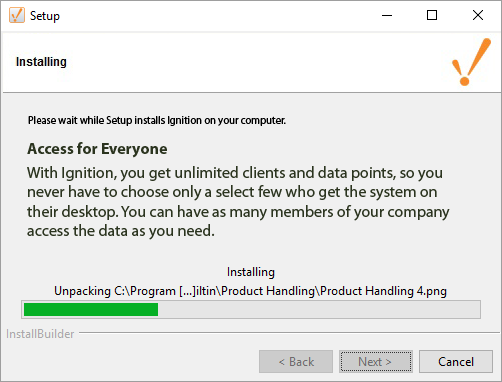
-
After the Setup Wizard shows Ignition installation is finished, make sure that the check box for Start Ignition now is selected, then click Finish.

A splash screen informs you that Ignition is starting. This may take a few minutes to finish.

That’s it! Ignition Installation is complete and the Gateway is then launched.
Your web browser opens the Gateway home page at http: //localhost:8088

Ignition installs itself as a Windows Service (Start > Control Panel > Administrative Tools > Services > Ignition Gateway), so it starts automatically when your computer starts up.
Automated Installation on Windows
You can automate Ignition installation across different machines using scripts. Ignition is then installed silently from a command shell without showing any user prompts.
Keep in mind that the installer cannot automatically start the Gateway after a silent installation. You can use the following command to start the Gateway:
net start ignition
Ignition-7.x.x-windows-x64-installer.exe --mode unattended --prefix "C:\some folder" --unattendedmodeui none
net start ignition
Flags
-- mode unattended(ensures that no prompts appear during installation)-- prefix "C:\some folder"(optional flag; if a value is set, then Ignition is installed in the specified folder, otherwise Ignition is installed in a default location under C:\Program Files)-- unattendedmodeui none | minimal(the none flag does not display any sort of graphic during installation; the minimal flag displays a small progress bar and nothing else)
Uninstalling Ignition on Windows
Be sure to back up your Gateway and unactivate your Gateway license.
During a new Ignition installation, an uninstaller executable is created.
When Ignition is uninstalled, the settings database and folder in /data is backed up to /data_<current date>, and modules and user-supplied JDBC jars in /user-lib are backed up to /user-lib_<current date>. Also, the Ignition service is removed from Windows installations automatically.
To run the uninstaller for Windows:
-
Open the Start menu and navigate to All Programs > Inductive Automation > Ignition.
-
Select Uninstall Ignition. The uninstaller wizard guides you through the uninstallation process.
You can also uninstall Ignition from the Windows Control Panel > Programs and Features section.
- Java 8+ (server), Java 6+ (client)
- Dual-Core Processor (32 or 64 bit)
- 4GB RAM
- 10GB free HD space
Also, running the installer will require root or administrator privileges
-
Go to the Inductive Automation website at www.inductiveautomation.com
-
Select Download > Current Release.
-
On the Ignition Downloads page, scroll down to System Installers and select the ignition-X.X.X-osx-installer.dmg file.
-
After the installer downloads, double-click on the DMG. You'll see a window appear that contains a ignition-x.x.x-osx-installer.app file

-
Double click on the APP file to start the installer. When prompted, enter your password for elevated installation privilege.
The Setup window welcomes you to the Ignition Setup Wizard.

-
Click Next.
-
Click the I accept the agreement button and click Next.

The Installation Directory window is displayed. The default Ignition installation directory on OS X is /usr/local/ignition, but this is configurable.
-
Ignition will need a user name to be installed under. The user needs to already exist on the system.

The Installation Mode window is displayed.
-
Select the platform you wish to install. The rest of this guide will use Ignition as the platform.
New in 7.9.2For Ignition Edge installations, select the Ignition Edge radio button then skip to step 12. More information on Edge can be found on the Ignition Edge page.
-
Select either the Typical or Custom mode.
The Typical installation includes Ignition with all of the HMI/SCADA modules. The only modules that are not installed by default are the MES modules.
The Custom installation lets you control and individually select the modules that you want installed.
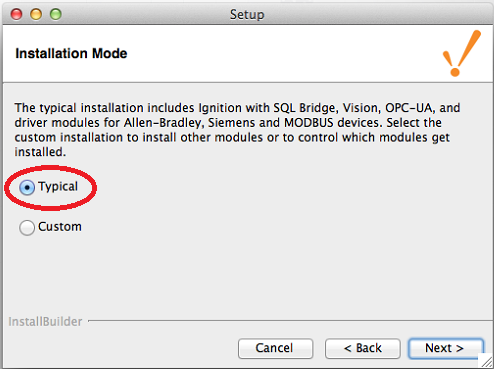
-
Click Next.
The Setup window is displayed.
If you selected Custom mode, in the Setup window you can select the check box next to the modules you want to install as part of the Ignition installation. To see a brief description of the module, click on the module name.
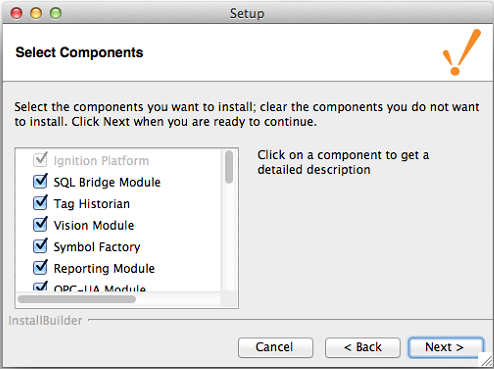
-
Click Next.
The Setup Wizard shows Ignition is now ready to install.
If you decide to change your selections, click Back to go back and make your changes.
-
Click Next.
Ignition will install the selected modules.
-
After the Setup Wizard shows Ignition installation is finished, make sure that the check box for Start Ignition now is selected, then click Finish.

A splash screen informs you that Ignition is starting. This may take a few minutes to finish.

That’s it! Ignition Installation is complete and the Gateway is then launched.
Your web browser opens the Gateway home page at http: //localhost:8088

Uninstalling Ignition on OS X
Be sure to back up your Gateway and unactivate your Gateway license.
During a new Ignition installation, an uninstaller APP is created.
-
Navigate to /usr/local/ignition

-
Run the uninstall.app file

-
The uninstaller wizard guides you through the uninstallation process.

- Java 8+ (server), Java 6+ (client)
- Dual-Core Processor (32 or 64 bit)
- 4GB RAM
- 10GB free HD space
Also, running the installer will require root or superuser privileges.
-
Go to the Inductive Automation website at [www.inductiveautomation.com]
-
Select Download > Current Release.
-
On the Ignition Downloads page, scroll down to System Installers and select the ignition-X.X.X-linux-x64-installer.run installer. If your computer runs on a 32- bit Linux, select the ignition-X.X.Xlinux-32-installer.run.
If you choose the wrong installer, an Error window is displayed letting you know the correct installer to use for your machine.
-
To install programs on Linux, you must run all the commands as root. Prefix everything with sudo or first run this command to set superuser privileges:
sudo su -
Open a command shell and navigate to the installer executable, by running the following command from the command line:
sudo chmod +x ignition-x.x.x-linux-xxxinstaller.run -
Start the installer executable.
tipThe installer can run in a graphical mode or text mode:
-
If you are running the installer in a shell in a graphical environment, the graphical installer opens automatically.
-
If you are running the installer in a headless Linux installation or through an SSH shell, the text installer opens automatically.
To start the text installer in a graphical environment, run the following command:
sudo ./ignition-X.X.X-linux-xxx-installer.run --mode text -
-
Agree to the licensing terms.
-
Ensure the installation directory is the default directory at
/user/local/bin/ignition:

-
Specify the user name under which Ignition is to be installed. For Ubuntu installations, the user that invoked sudo is used by default. For other Linux installations, this field is initially blank.
noteThe Linux installer requires a user name to set the permissions on the folders created by the installer. This user is then able to start and stop Ignition, run the Gateway Control Utility, and the command line interfaces.
The binaries in the installation folder are still owned by root and cannot be modified without root access. The selected user must already exist on the system before starting the installer.


-
If the Java Installation window is displayed, type the full path to the Java executable.
noteNormally, the installer is capable of auto-detecting a Java 8 installation that has been installed through APT or some other Linux package management tool. In these cases, the installer uses that Java installation and skips this step.
However, if you have installed Java by extracting the Java binaries to a folder and adding them to the system PATH, the installer is unable to find the Java binaries. You must provide the installer with a full path to the Java executable.


-
Select the platform you wish to install. The rest of this guide will assume Ignition as the platform.
New in 7.9.2For Ignition Edge installations, select the Ignition Edge radio button (Graphical mode) or enter 2 (Text mode), then skip to step 13. More information on Edge can be found on the Ignition Edge page.
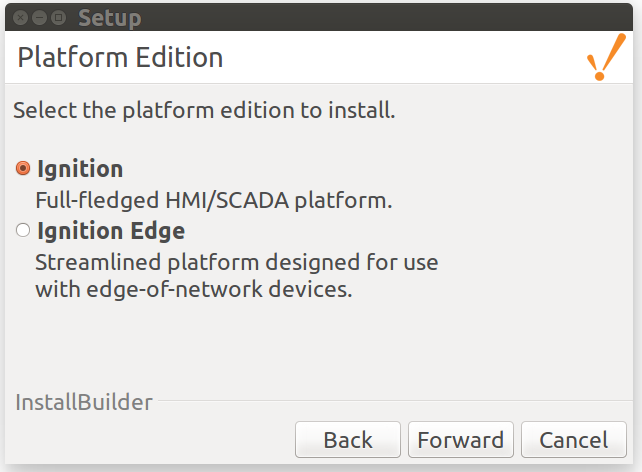
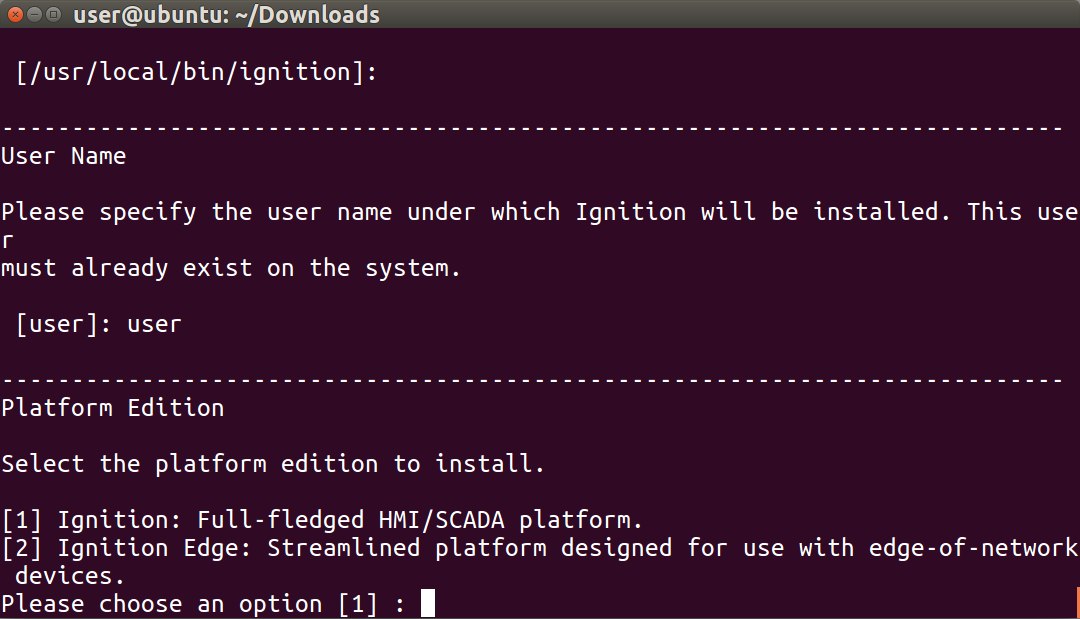
-
Select either the Typical or the Custom installation mode.
The Typical mode installs everything that you need to get started.
The Custom mode lets you add optional modules, such as the OEE Downtime module. It also lets you control and select which modules get installed.


If you select Custom Mode, the Select Components window is displayed.
-
In Graphical mode, to view a brief description of the module, click on the module name. Selecting the check box next to a module installs the module as part of the Ignition installation. Clearing the check box next to a module prevents the module from being installed.
-
In Text mode a list of all the modules are displayed one at a time. Type y to install the module, and type n to prevent the module from being installed.

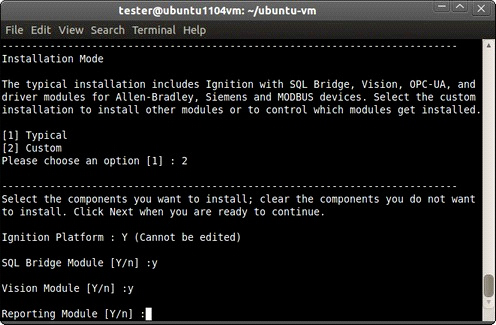
Ignition is now ready to be installed. At this point, you can click the Back button (graphical mode) to change your selections. For the text mode, you can only abort the installation at this point by typing n.
-
-
Click Forward (graphical mode) or type y (text mode) to finish the installation.
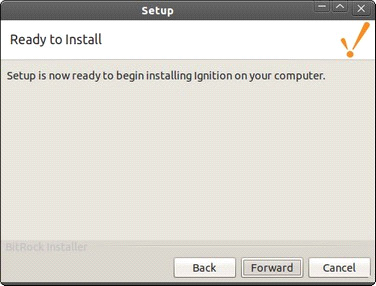
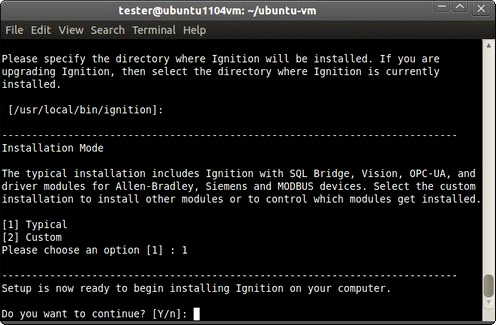
-
When the installation is complete, click Finish (graphical mode) or type y to start Ignition (text mode). Ignition is started as a background process.

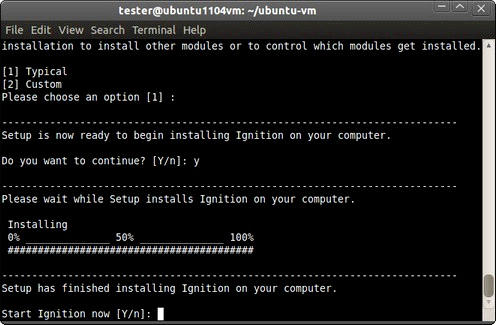
Once the Ignition Gateway starts up, your web browser opens and brings you to the Gateway home page at http://localhost:8088.
Ignition Service
Stop and Start Ignition
After installation, you can start and stop Ignition with the following commands:
/etc/init.d/ignition start
/etc/init.d/ignition stop
Remove Service
When installing under Ubuntu, Ignition starts automatically whenever the computer reboots. If you wish to stop this behavior, you need to use the update-rc.d tool to remove the service (uninstalling Ignition also removes the service) as follows:
/etc/init.d/ignition stop
update-rc.d -f ignition remove
rm /etc/init.d/ignition
When installing under other Linux distributions, use that distribution's method to automatically start a program after reboot. For example, this command auto-starts Ignition installed in a Fedora 15 system (run as root user):
chkconfig --level 2345 ignition on
Set the system PATH
For Ubuntu installations, the installation directory is automatically appended to the system PATH. You can start programs like the Gateway Control Utility from the command line without specifying a complete path to the installation directory.
Note that after installation, you need to close and reopen the command shell for the PATH change to take effect. For other Linux installations, you need to manually add /usr/local/bin/ignition (or your installation directory) to any script that can set the system PATH (such as .profile or .bashrc).
Automated Installation on Linux
You can automate Ignition installation across different machines using scripts. Ignition is then installed silently from a command shell without showing any user prompts.
Keep in mind that the installer cannot automatically start the Gateway after a silent installation. Use the /etc/init.d/ignition start command as shown in example below.
sudo ./ignition-7.x.x-linux-x64-installer.run --mode unattended --prefix /somefolder/bin/ignition --unattendedmodeui none
/etc/init.d/ignition start
Flags
-- mode unattended(ensures that no prompts appear during installation)-- prefix /somefolder/bin/ignition(optional flag; if a value is set, then Ignition is installed in the specified folder, otherwise Ignition is installed in /usr/local/bin/ignition by default)-- serviceuser username(allows a Linux system user to be installed (that is, a user that cannot log in to the OS))-- unattendedmodeui none | minimal(the none flag does not display any sort of graphic during installation; the minimal flag displays a small progress bar and nothing else)
Uninstalling Ignition on Linux
Be sure to back up your Gateway and unactivate your Gateway license.
During a new Ignition installation, an uninstaller executable is created in the installation directory: the default directory is /usr/local/bin/ignition
When Ignition is uninstalled, the settings database and folder in /data is backed up to /data_<current date>, and modules and user-supplied JDBC jars in /user-lib are backed up to /user-lib_<current date>. Also, the Ignition service is removed from Ubuntu Linux installations automatically.
Linux - Using Downloaded Installer
Ignition 7.3 or later installations on Linux contain an uninstaller executable.
To run the uninstaller,
-
Open a command shell and navigate to
/usr/local/bin/ignition(or your installation folder). -
As root or sudo, run
./uninstall
Linux Ignition installations before 7.3 used a zip file that did not form an installation. Since these installations were never created with an installer executable, no uninstaller executable was ever generated. This is true even if using a 7.3 or later installer executable to upgrade an installation from before 7.3. For installations before 7.3, you must manually remove the Ignition folders using the commands below:
/etc/init.d/ignition stop
*Ubuntu only* update-rc.d -f ignition remove
rm /etc/init.d/ignition
rm -rf /usr/local/bin/ignition
*Recommended* mv /var/lib/ignition/data /var/lib/ignition/data_<current date>
*Recommended* mv /var/lib/ignition/user-lib /var/lib/ignition/user_lib_<current date>
*Recommended* mv /etc/ignition /etc/ignition_<current date>
rm -rf /var/log/ignition
